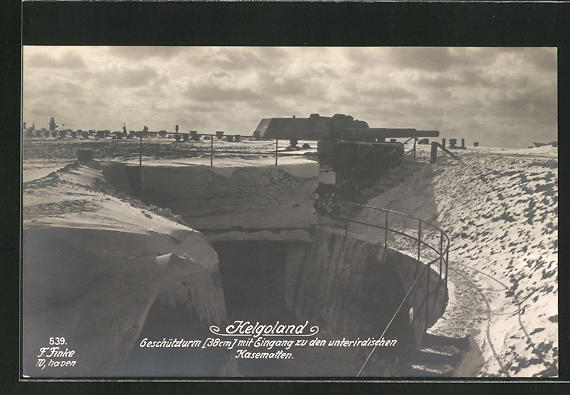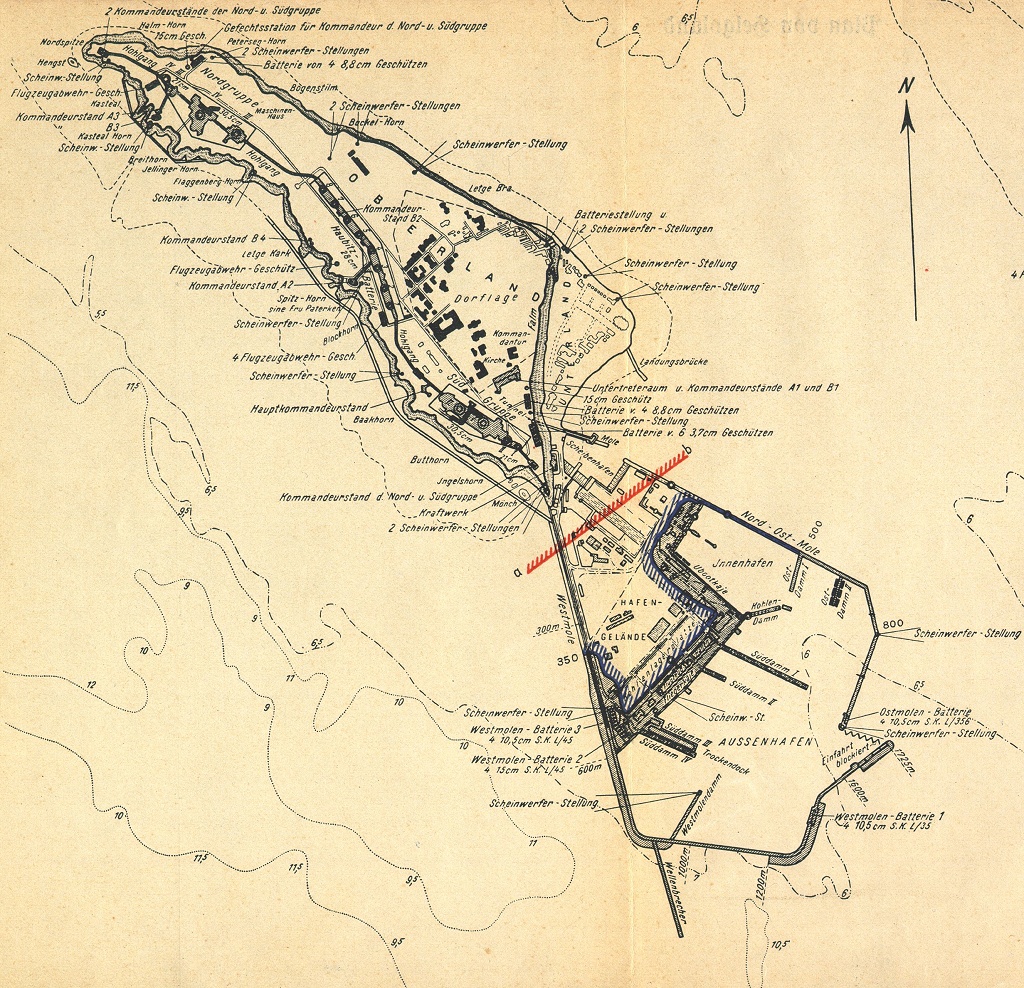| Jutland:
The German Gibraltar
By Mike Bennighof, Ph.D.
January 2022
 As Germany began construction of what would become the High Seas Fleet in the 1890’s, it also undertook a massive program of port, base and canal construction to service the Empire’s new navy. Wilhelmshaven, founded in 1869, expanded rapidly as did the other North Sea ports. And protecting them all would be a massive fortress on the island of Helgoland, soon declared “Germany’s Gibraltar” in Imperial propaganda. As Germany began construction of what would become the High Seas Fleet in the 1890’s, it also undertook a massive program of port, base and canal construction to service the Empire’s new navy. Wilhelmshaven, founded in 1869, expanded rapidly as did the other North Sea ports. And protecting them all would be a massive fortress on the island of Helgoland, soon declared “Germany’s Gibraltar” in Imperial propaganda.
Located a little more than 40 miles off the north German coast, the small island of Helgoland (and its usually-uninhabited neighbor, Düne) apparently fell under Danish rule during the Middle Ages. Though inhabited since Neolithic times, the island made little impact on history except for a brief note in Pliny the Elder’s histories as a source of amber. The “Holy Island” apparently gained its name through association with Forseti, the Norse god of justice. In those days the two small islands were one, and noted as a herring fishery, limestone quarry and pirate haven. The island passed to the Duchy of Schleswig in 1544 and back to Denmark in 1714 at the end of the Great Northern War.

Helgoland from the air, with Düne in the background.
New Year’s Eve 1720 brought massive change to the island: a tsunami-like storm surge struck the limestone quarry, smashing through the cliffs weakened by centuries of mining. With the first dawn of the year 1721 it became apparent that Helgoland was now two islands, with the land bridge between them permanently submerged. Many inhabitants and buildings also disappeared under the waves.
British troops landed on the undefended main island in 1807, seizing it from the French-allied Danes. Helgoland (Heligoland to the British) became a center for British secret operations in French-occupied northern Germany and a transit point for smugglers bringing English goods past the French Continental System’s embargo – more cargo passed through Helgoland than Hamburg in those years. The King’s German Legion also maintained its recruiting center there.
The peace treaties ending the Napoleonic Wars confirmed Britain’s possession of Helgoland. The tiny garrison departed in 1821, as the British government declined to turn the island into a fortress or naval base. Instead it became a vacation spot, a haven for both English and German poets, writers and painters. German revolutionaries plotted there before 1848, and hid there after 1848. The Germans and Danes fought naval battle within sight of the beaches in 1849, and the Austrians and Danes repeated the action in 1864.
After the founding of the German Empire in 1871, German newspapers began to call for unification of Helgoland with Germany, though it had never been German territory. The small native population spoke a Frisian dialect, in common with the peoples of the barrier islands and the German coast and in the north-eastern Netherlands, but their “German-ness” was rather limited. Chancellor Otto von Bismarck had apparently prompted the editorials; when the French offered Cochin China (southern Viet Nam around Saigon) as part of the peace negotiations in 1871, Bismarck put out feelers to the British to see if they would let him flip the French colony to Britain in exchange for Helgoland. The British declined, and Bismarck instead insisted on Alsace, Lorraine and a massive cash indemnity.

One of Helgoland's 305mm turrets.
Construction of the Kiel Canal between the North and Baltic Seas began in 1887, making the acquisition of Helgoland seemingly more urgent for defense of the canal’s western entry (and to deny it to a potential enemy). Britain placed far less value on the island than did the Germans, and in 1890 Bismarck’s successor, Leo von Caprivi, managed to include its cession to Germany in a colonial treaty clarifying British and German interests in Africa. Though Bismarck planted newspaper accounts calling it the trade of the valuable island of Zanzibar for a useless rock in the North Sea, Germany had only limited rights in Zanzibar and Caprivi gave up very little while gaining undisputed control of what became German East Africa. Helgoland was simply a throw-in.
The British did not grant the Helgolanders citizenship or the right to emigrate to England, but did extract a few concessions for the local population. They would be tax-exempt for 15 years, they would have special customs exemptions (some of which still apply today) and only those born after British rule ended would be subject to conscription.
With Helgoland now in German hands, work began immediately to turn it into a fortress. Plans were complete by the next year, and construction began on the first underground bunkers in October 1891. By January workers were pouring concrete for artillery revetments and building new docks to allow heavy equipment to be landed.
Helgoland’s batteries were complete by 1894: four 210mm (8.2-inch) naval rifles and eight 280mm (11-inch) coast-defense howitzers. All were emplaced on the island’s upper plateau to maximize their radius of fire. British newspapers claimed that 142 smaller guns had been installed in batteries chipped out of the island’s cliffsides, which the Germans did not deny, but this was a fabrication – the openings in the cliffs spotted by the enterprising reporters were actually air shafts.
With the coming of dreadnought battleships, Helgoland’s fortifications and artillery received a large-scale upgrade to keep up. Four twin turrets with 305mm (12-inch) guns, the same SK L/50 weapons carried by the new Helgoland-class battleships, were mounted on the plateau in two pairs, one set at either end of the island. Though the turrets superficially resembled those carried by the island’s namesake battleship, they were made of cast steel rather than the rolled armor plate of the battleship turrets and thus were not as proof against enemy fire.
Two further turrets with 170mm (6.7-inch) guns completed the new coast-defense artillery; another twin 305mm turret was emplaced on the coastal island of Wangerooge to cover the entry to Wilhelmshaven. German engineers bored deep into Helgoland’s granite core to build new ammunition dumps, barracks and a hospital, with underground tunnels connecting all of these installations with the artillery positions.

A 1930’s map of Helgoland's
batteries, showing pre-1914 positions as well.
In addition to the heavy artillery, the island’s small harbor was upgraded in 1908 with a mole and seawall, with facilities to support torpedo boats and on a short-term basis light cruisers. Since German crews lived in barracks ashore when not at sea, larger vessels could not have been based at Helgoland even if the harbor could have accommodated them as there was no space to house tens of thousands of men.
As naval construction continued, the tourism industry faded. The wealthy visitors no longer came, and the island now catered to a clientele that had less money to spend. The island also became popular with Austrian tourists. The heavy military spending brought no prosperity to the islanders, few of whom had been enthusiastic about joining the Empire.
When war came in August 1914, the German Navy took full control of Helgoland, deporting the civilian population to the mainland – considered “half English” and potential saboteurs and spies, they could not be trusted nor did the Navy wish to use limited cargo space to feed them. While fighting took place in nearby waters, Helgoland was not attacked and only had two opportunities to fire her guns in anger.
British troops occupied Helgoland after the war, demolishing the fortifications and the batteries. The Helgolanders returned as well, hoping for a return to British rule or, were that not possible, to Denmark. Neither effort bore fruit, other than to gain the Helgolanders their own local government and a reputation as would-be traitors.
Re-arming began in 1934, with the artillery restored, new anti-aircraft batteries erected and submarine pens built. The Helgolanders were not very good Nazis, and as the island had only four Jews the Nazis instead turned their wrath on gays and lesbians, a hunt that quickly ended when several of those so identified turned out to be among the few party activists on Helgoland. The National Socialists had grand plans for Helgoland, to dredge huge amounts of fill from the sea floor and build up the island’s size to serve as a major naval base. Some work began in 1938, but construction halted with the start of the Second World War.
 As in the First World War, Helgoland saw little action in the Second, serving mostly as a station for the air-rescue service to locate downed fliers in the North Sea. The Royal Air Force treated Helgoland to a thousand-plane raid in April 1945 featuring huge Grand Slam bombs that did massive damage. In 1946, the British set off huge stocks of British and German ammunition in what is still considered history’s largest human-made non-atomic explosion. Much of the island collapsed in the wake of the blast. As in the First World War, Helgoland saw little action in the Second, serving mostly as a station for the air-rescue service to locate downed fliers in the North Sea. The Royal Air Force treated Helgoland to a thousand-plane raid in April 1945 featuring huge Grand Slam bombs that did massive damage. In 1946, the British set off huge stocks of British and German ammunition in what is still considered history’s largest human-made non-atomic explosion. Much of the island collapsed in the wake of the blast.
What remains of Helgoland is again a tourist spot, without military functions, though it has never regained its appeal. Attempts to use its special customs status to attract shoppers from mainland Germany have earned the island the derogatory nickname of Fuselfelsen (the “booze rock”; it’s nastier in the original); quite a comedown for Germany’s Gibraltar.
Click here to order Jutland right now.
You can order Jutland Battle Analysis right here.
You can order Jutland: Dogger Bank right here.
Sign up for our newsletter right here. Your info will never be sold or transferred; we'll just use it to update you on new games and new offers.
Mike Bennighof is president of Avalanche Press and holds a doctorate in history from Emory University. A Fulbright Scholar and NASA Journalist in Space finalist, he has published more books, games and articles on historical subjects than anyone should.
He lives in Birmingham, Alabama with his wife, three children, and his Iron Dog, Leopold.
Want to keep Daily Content free of third-party ads? You can send us some love (and cash) through this link right here.
|
